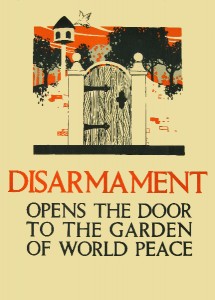One Hundred Years of Working for Peace
Sitting in the Admissions Office, it can be difficult to gain real knowledge of all that’s going on at the School. And whatever I don’t know much about, I usually don’t write about. So I was lucky that the World Peace Foundation agreed to write a series of blog posts to describe their very interesting work. Here is the first post, written by Bridget Conley-Zilkic, the WPF Research Director and Assistant Research Professor at Fletcher. Two more posts will appear on the coming two Wednesdays.
One of the most fragile books on the shelves at Tufts University’s Tisch Library must surely be Jonathon Dymond’s excessively titled piece An Inquiry into the Accordancy of War with the Principles of Christianity and an Examination of the Philosophical Reasoning by Which It is Defended with Observations on the Causes of War and Some of Its Effects (1834), donated to Tufts Library in 1861. Its cover is a time-worn blue and gold; its pages have already faded from yellow to light brown. Is it possible that the founder of the World Peace Foundation (WPF), Edwin Ginn, pulled this same book off the shelves when he was a student at Tufts in 1858-1862? And would Ginn be proud to know that the foundation he created in support of world peace in 1910 came “home” in a manner of speaking to Tufts University’s The Fletcher School in 2011? For Ginn was not only a Tufts almnus and trustee, his name also graces the library at The Fletcher School, founded by his donation.
A self-made man and publisher of educational textbooks, Ginn was part of an emerging international movement at the turn of the last century that traced its conceptual roots to Immanuel Kant’s notion of “perpetual peace” based upon a “league of nations.” While not all were pacifists, many participants in the movement believed that advancing international commerce, democracy, law, and diplomacy would provide the building blocks for a definitive era of global peace.
The WPF was established in lines with this approach for the purpose of:
“…educating the people of all nations to the full knowledge of the waste and destructiveness of war and of preparation for war, its evil effects on present social conditions and on the well-being of future generations, and to promote international justice and the brotherhood of man, and generally by every practical means to promote peace and good will among all mankind.”

Edwin Ginn died on January 21, 1914. He did not live to witness the horrors of World War I, let alone those of World War II. But since his time, two of the three pillars of world peace that he identified have been constructed: inter-state cooperation through the United Nations and other bodies, and mechanisms for the lawful and nonviolent resolution of international disputes. By contrast, his third goal of disarmament has not been achieved.
Meanwhile, especially in the last half century, the number and intensity of violent conflicts has fallen, and their nature has changed. Today, war is often pursued by non-state actors, including informal globalized networks, and most violence takes place within countries, with blurred boundaries between armed conflict, crime and the enforcement of government will. These shifts in the trends of warfare deeply challenge the conceptualization and work of peace; a fact that animates the program of the World Peace Foundation today.
Beginning in 2011, with the move to The Fletcher School, Alex de Waal was brought on board as the executive director, and soon thereafter he hired Bridget Conley-Zilkic as research director and Lisa Avery as administrative assistant. The WPF today aims to provide intellectual leadership on issues of peace, justice and security. We believe that innovative research and teaching are critical to the challenges of making peace around the world, and should go hand in hand with advocacy and practical engagement with the toughest issues. As the Foundation enters its second century, our underlying theme is reinventing peace for the globalizing world.
In our next blog essay, learn about our on-going projects.
